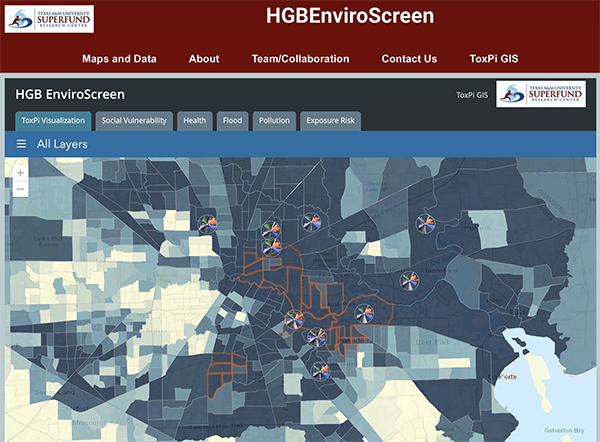CVM Researchers Develop New Tool To Help Communities Access Data On Environmental Risk
Story by Margaret Preigh, CVMBS Communications

Researchers at Texas A&M have developed a tool called HGBEnviroScreen that makes data reporting environmental and social risks more accessible to community members and community-based organizations (CBOs).
Published in the International Journal of Environmental and Public Health, this project is a collaboration with North Carolina State University and the Environmental Defense Fund. The project team, led by Dr. Weihsueh Chiu, a professor at the Texas A&M College of Veterinary Medicine & Biomedical Sciences (CVM), created the online tool to serve the Houston-Galveston-Brazoria (HGB) region in integrating and visualizing national and local data on environmental health to address regional concerns.
The project is part of the Texas A&M Superfund Research Center’s five-year, $10 million grant from the National Institute of Environmental Health Sciences (NIEHS) that is comprehensively evaluating the complexities of hazardous chemical exposures, potential adverse health impacts, and potential hazards of exposures to complex mixtures through a series of multi-disciplinary projects that derive from a case study utilizing Galveston Bay and the Houston Ship Channel.
Historically disadvantaged communities are often subject to higher environmental risks resulting from both industrial and natural impacts. These communities are also less likely to have access to data that evaluates the scope and extent of these risks.
“One of the issues is that communities don’t have good access to data, even if it’s freely available,” Chiu said. “They don’t know how to collect it, how to organize it, and how to visualize it in a way that that can be meaningful to help them to advocate for themselves.”
HGBEnviroScreen compiles data from five key categories—social vulnerability, baseline health, environmental exposures and risks, environmental sources, and flooding—to create a comprehensive evaluation that can be easily accessed and understood by community members and CBOs. The tool then visualizes the data for each census tract in a pie chart-like graphic known as “ToxPi,” while also providing an overall score of community vulnerability.
Existing tools do make some of this data publicly available, but either each metric is displayed on a separate screen, or only the overall score is shown, making it difficult for individuals unaccustomed to the environmental justice field to see how different elements of environmental health fit together.
“This tool can help communities develop action plans as to how they’re either asking the municipalities for better services or working with the local businesses and industry to make sure that their community is not being overly exposed,” Chiu said.
Chiu hopes that this tool will act as an initial screen to point out which specific concerns a community should focus on first. Equipping community action groups with not only the data they need to identify problems, but also a platform on which to interpret this data creates increased accessibility that allows nonspecialists to become involved in the conversation of their community’s health.
This information, drawn from 1,090 census tracts in the HGB region, includes common environmental justice concerns, like social vulnerability and air pollution, in addition to HGB-specific concerns like flooding and a large industrial presence.
The multifaceted environmental vulnerabilities faced by the HGB region creates a “perfect storm” that puts the area at increased risk, and HGBEnviroScreen can help local authorities focus in on weaker areas to mitigate threats, according to Chiu.
Dr. Sharmila Bhandari, a postdoctoral researcher at the CVM who also contributed to this project, sees tools such as HGBEnviroScreen as important to the future of environmental justice movements. She says that the information compiled by these tools can not only aid in planning future environmental initiatives, but also to recovering from disasters after they occur.
“This tool can be really helpful to provide area-specific information to various stakeholders in order to inform how to better assess exposure and risk, as well as how to reduce exposure during and after an emergency storm event.”
HGBEnviroscreen is accessible to the public at https://hgbenviroscreen.org.
###
For more information about the Texas A&M College of Veterinary Medicine & Biomedical Sciences, please visit our website at vetmed.tamu.edu or join us on Facebook, Instagram, and Twitter.
Contact Information: Jennifer Gauntt, Director of Communications, Texas A&M College of Veterinary Medicine & Biomedical Sciences; jgauntt@cvm.tamu.edu; 979-862-4216


